These days, Nissan is struggling for survival. Last year, it tried to merge with Honda, but the deal fell apart when Honda saw it more as a takeover than a merger. The company hasn’t really been seen as much of a leader in the industry for many years. But 15 years ago, many perceived it as a leader in the field of electric vehicles. While Tesla had launched the first long-range EV with a lithium ion battery in the form of the first Roadster, Nissan brought out the first relatively affordable modern EV in the shape of the original Leaf. Then-CEO Carlos Ghosn announced big plans to introduce many more EVs in the 2010s, but those plans largely stalled and Nissan has floundered. Fifteen years after the debut of the original Leaf, Nissan is trying to reboot with an all-new generation and we’ve had a chance to drive it. Will this be the car that kick-starts Nissan?
The original Leaf was a compact hatchback at a time when that form factor was still selling reasonably well. Unfortunately it had several challenges.
First off, it was a bit peculiar looking — something like an alien insect. In its original form, it also had a pretty short range. At the same time that the original Tesla Roadster had more than 200 miles of range, the Leaf came to market with just 73 miles.
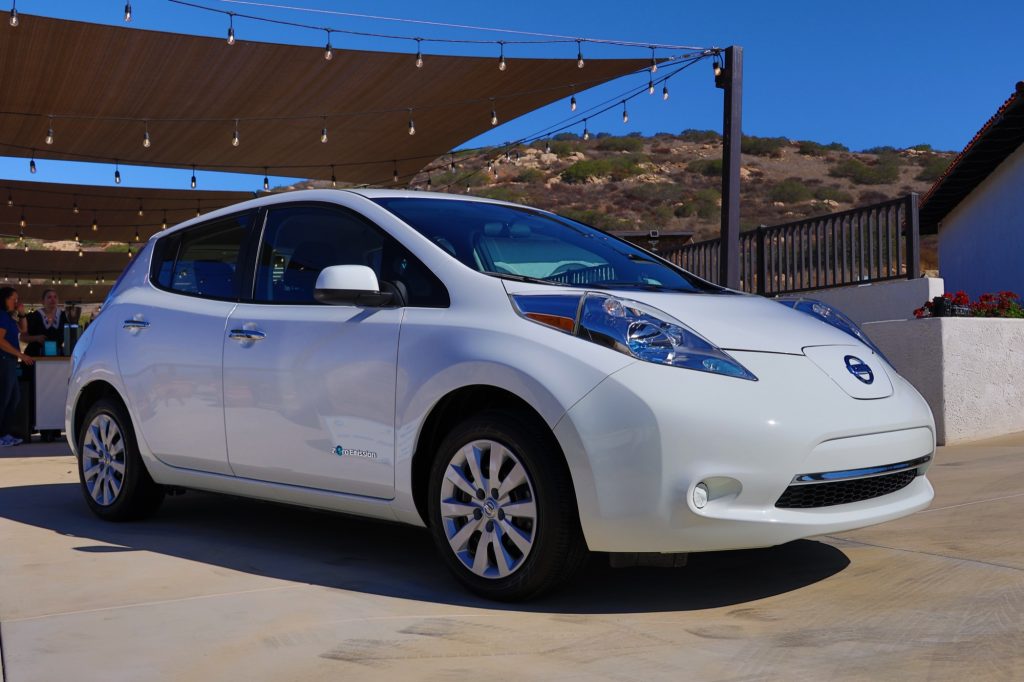
But perhaps the biggest issue with the early Leaf was the decision to use an air-cooled battery pack. Most of the early US sales of the Leaf took place in warm weather regions like California and Arizona. Unfortunately, the inadequate thermal management system meant that owners using the car in very hot weather like Phoenix in August started seeing some pretty significant premature degradation of the battery. That’s why it’s probably wise to avoid buying a used early Leaf as David Tracy found out. Over time, Nissan did improve the batteries and the thermal management although the battery remained air-cooled all the way until this year.
It wasn’t all bad for the old Leaf. It was reasonably roomy and was the first EV to include DC fast charging. Since it launched before the CCS or Tesla NACS standards were developed, it used what was available, the Japanese CHAdeMO connector. Max charging speeds were limited to 50-kW but that was fine given the cooling challenges and the mere 24-kWh capacity of the first iteration.
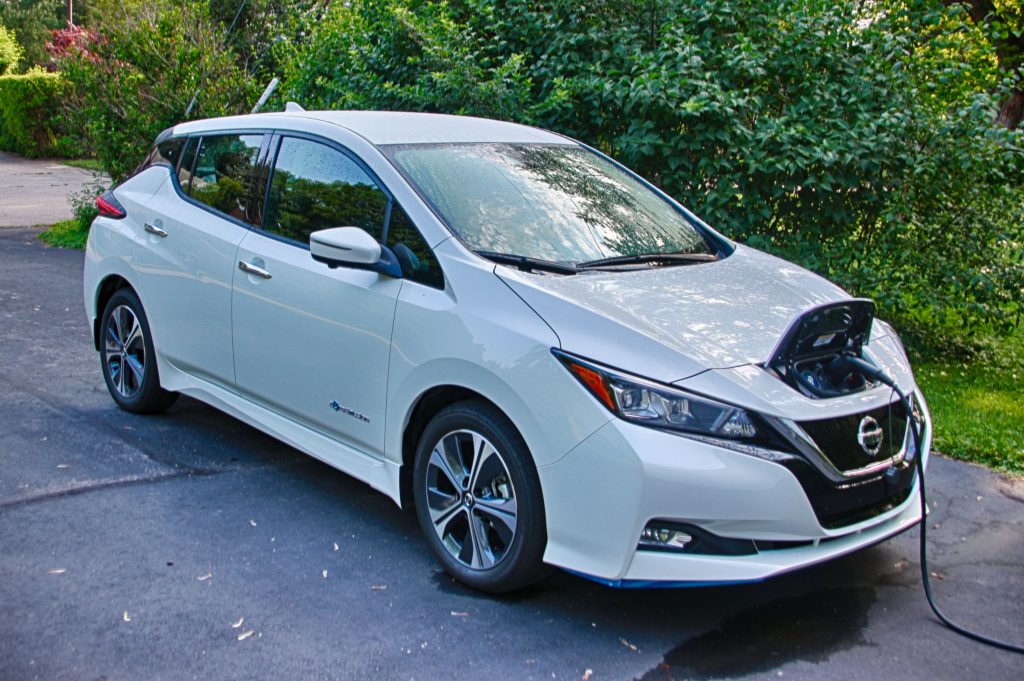
In 2017, a second-generation arrived that retained the original platform but got an all-new skin that looked more conventional. The battery grew to 40-kWh with the range getting bumped to 150-miles and eventually a plus model with a 60-kWh battery and 220 mile range joined the lineup.
A Complete Reboot
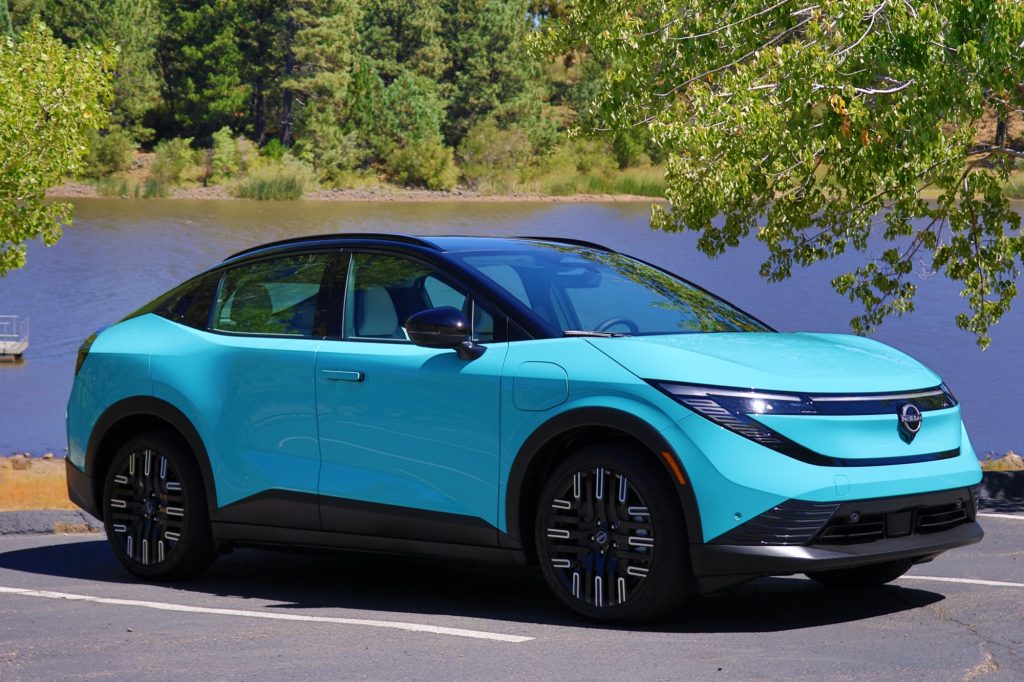
For 2026, the Leaf gets a complete reboot that finally abandons almost everything from the original. Interestingly, Nissan has actually made it smaller than before, something that is almost unheard of in this industry. It’s about 3-inches shorter and 0.8-inches narrower with 0.4-inches less wheelbase.
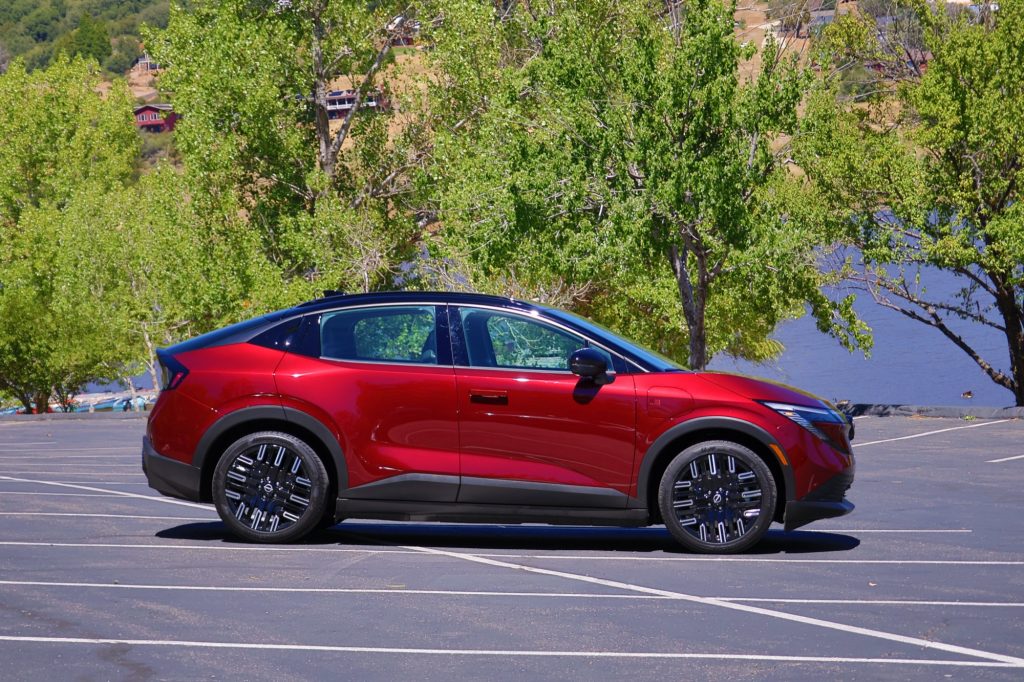
What may be most crucial to the potential success of this new Leaf though is the shape which most would now describe as a crossover coupe.
Let’s be completely clear, there is nothing about this car that is an SUV apart from that profile. This of course is no different from the vast majority of vehicles that are marketed as SUVs or crossovers. I personally don’t like that we have to call something an SUV just to get potential buyers to even consider it now even when it is very clearly a car, but such is the nature of consumer perceptions in the 2020s. Nonetheless, I’m going to call this a compact hatchback.
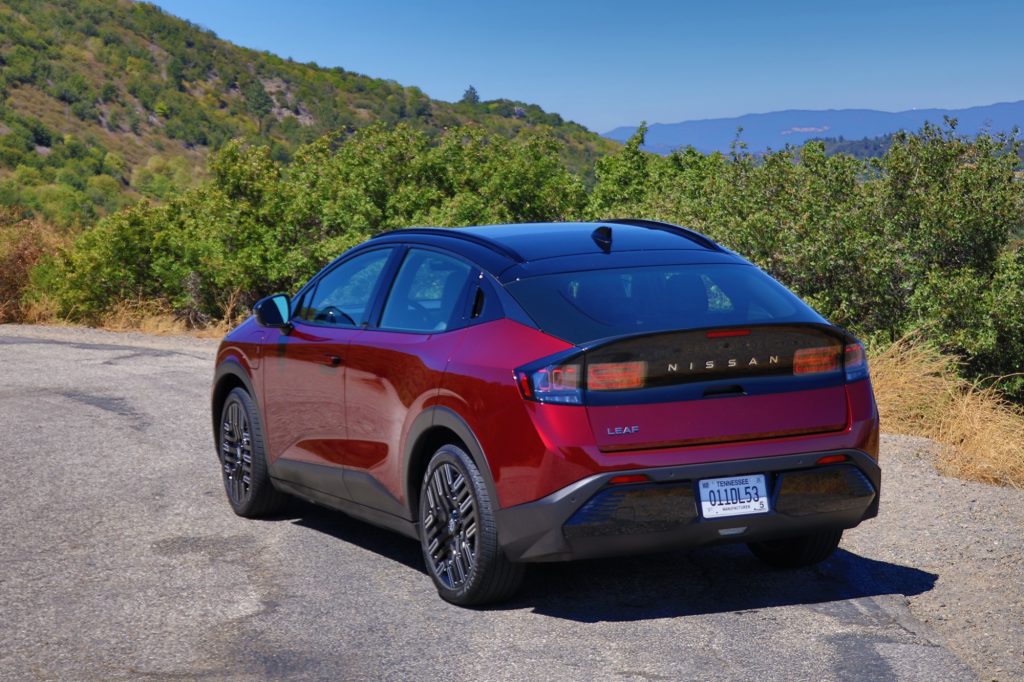
I first saw the new Leaf two years ago when we visited the Nissan design center following the Japan Mobility Show. Nissan’s design chief Alfonso Albaisa gave us a tour of more than two dozen vehicles, essentially everything the company was working on for the next several years. Many of those vehicles have since launched including the new Armada and QX80, the Murano and the cool little Micra that Americans won’t get because we can’t have nice things. Other stuff I still can’t talk about while others may or may not actually make it to production due to the shifting market dynamics for EVs and Nissan’s financial health. That would be a real shame because there was some really interesting product that was destined for America.
When I laid eyes on the new Leaf, my first thought was that it’s a ⅞ scale Ariya which is not at all a bad thing. It definitely has a strong family resemblance to the midsize EV but with some interesting details that set it apart. Starting at the front, one element we’ve seen on recent models like the Kicks and Murano is the stacked horizontal light bars as a signature in the corners. On the Leaf this is executed as hollow rather than solid rectangles.
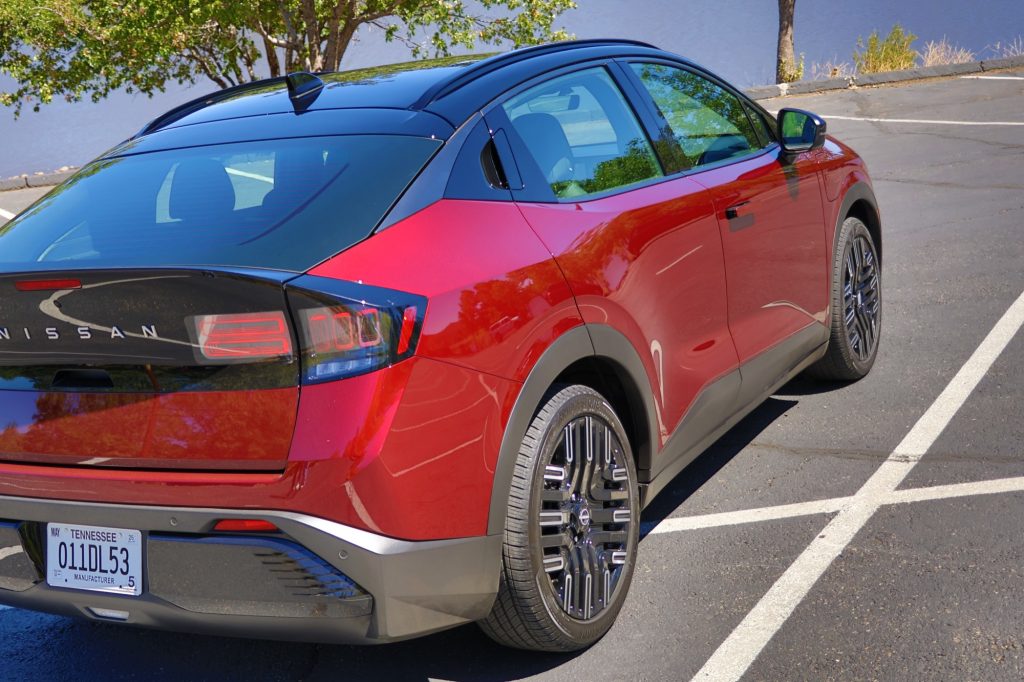
Along the sides, the more conventional door handles of the Ariya are replaced with somewhat hidden units. Pop-out handles are used on the front doors and sit flush for reduced drag when the Leaf is in motion. The rear door handles are hidden in the C-pillar.
Around the back, we see the new signature flourish of the Leaf in the taillamps which consist of three vertical bars and two horizontal. These bars represent the Japanese digits for two and three which in the language are pronounced as ni and san. It’s a clever little easter egg if you look at the right rear corner. If you’re reading Japanese which goes right to left, then you’ll want to focus on the left rear corner which is the mirror image.
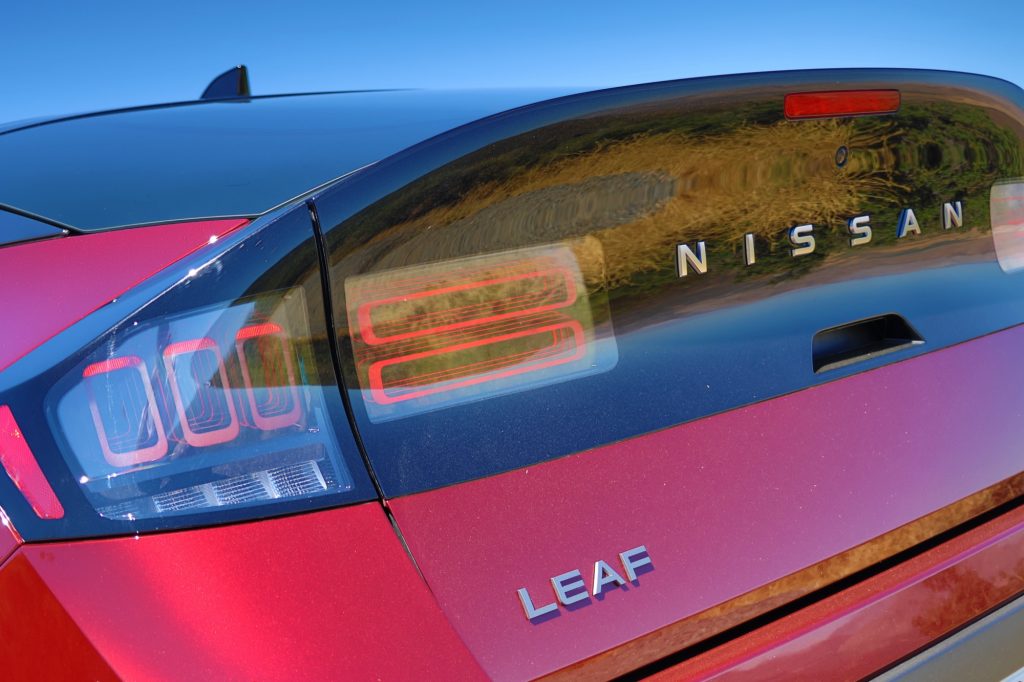
According to Nissan, that same iconography shows up in 16 places on the car – we spotted eight – on the door sills, the charge port doors and next to the outboard dash vents in addition to the taillamps. The two horizontal bars also provide a bit of connection to the Z32 300ZX and the current RZ34 Z. I particularly like how these lights have been executed to appear as layers that provide the appearance of depth to the lights.
There is one other important exterior detail, the two charging ports on each front fender. The first two Leaf generations always had the charge ports under a flap above the front bumper. There was an SAE J1772 port for AC charging and the CHAdeMO port for DC charging side by side. The Ariya for North America dropped CHAdeMO in favor of a CCS port on the right front fender.
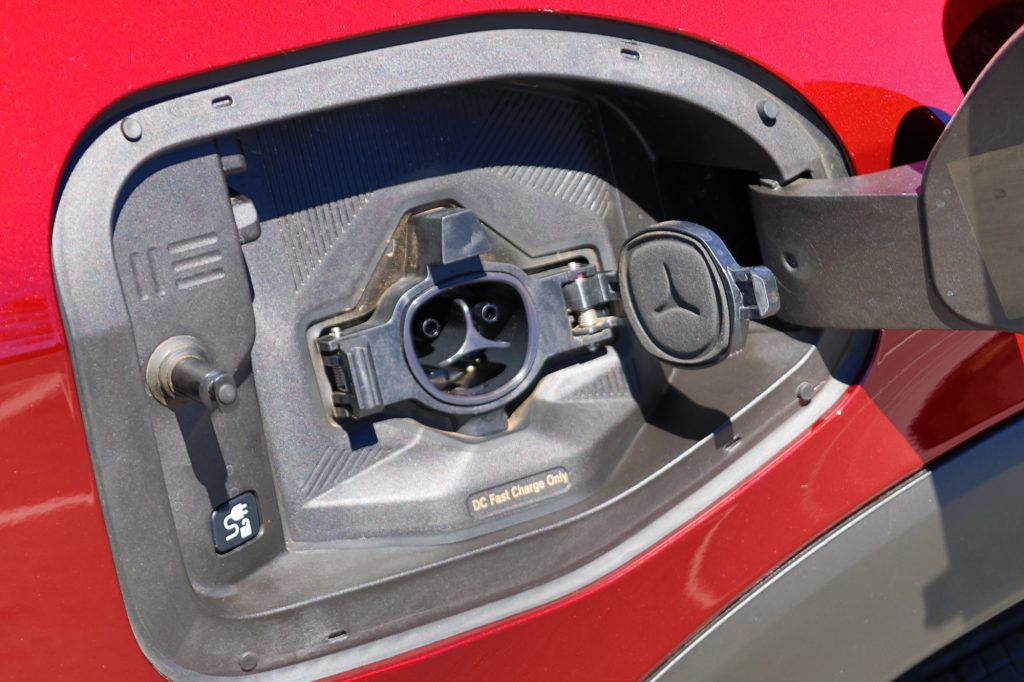
On the Leaf, there is a J1772 port on the left front fender for AC charging at home and a J3400/NACS port on the right front. Nissan explains that they retained the J1772 on the left because it’s close to where the driver gets out and they can easily plug in when they get home. The NACS port on the right will be more convenient for drivers if they choose to use a Tesla Supercharger because the V3 dispensers have short cables that will reach this position. The NACS port only supports DC charging for now because the decision to switch ports came late in the development process and there wasn’t enough time to redesign the whole wiring circuit to also support AC through that port. That is promised for a future update to the Leaf.
In the Cabin
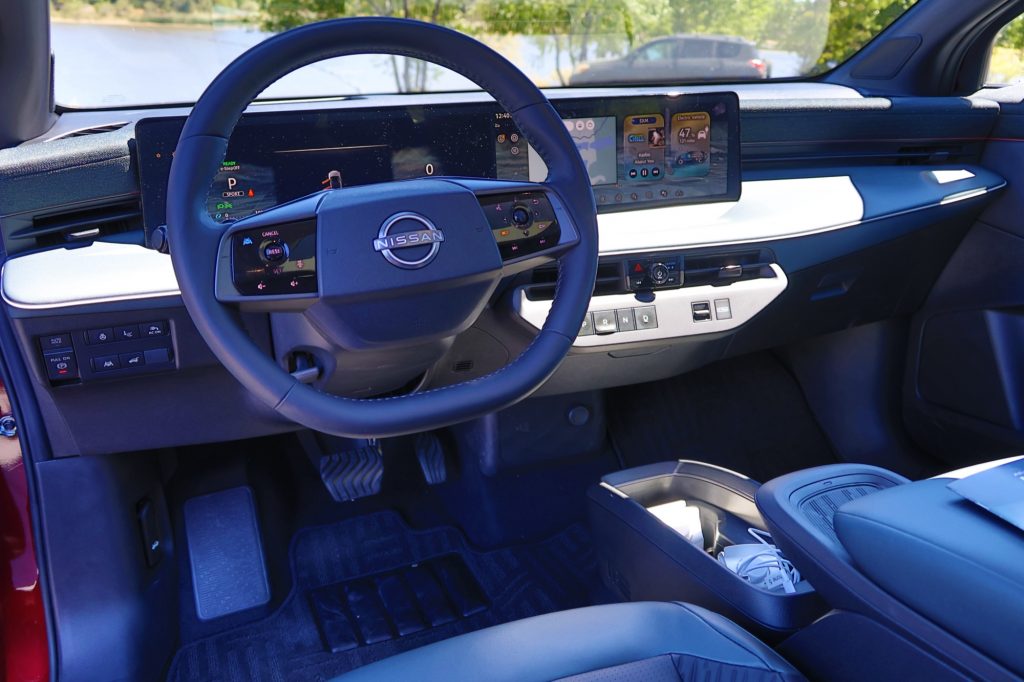
The Ariya resemblance carries over to the interior of the Leaf. The design is clean and uncluttered. The peculiar gear selector of the old Leaf has been discarded in favor of the push button layout that Nissan has been favoring in recent years. While I appreciate physical controls over touch controls in a car, I’d prefer a steering column stalk over the push buttons for this use case but I could live with the buttons.
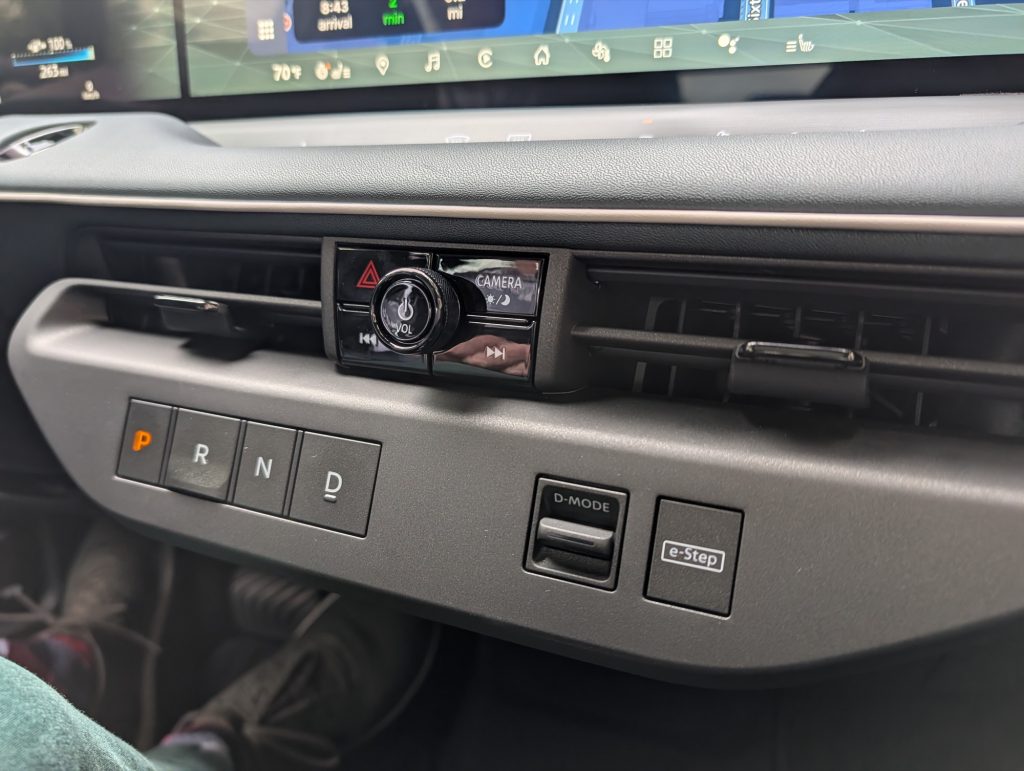
Like the Ariya, there is a large panel on top of the dash containing two displays, the instrument cluster in front of the driver and the infotainment touchscreen to the right. On the S and S+ trims, the displays are each 12.3-inches and the infotainment runs an updated version of Nissan’s software that has been in use for many years. It’s adequate, but most drivers will probably take advantage of the standard wireless Apple CarPlay or Android Auto capability.
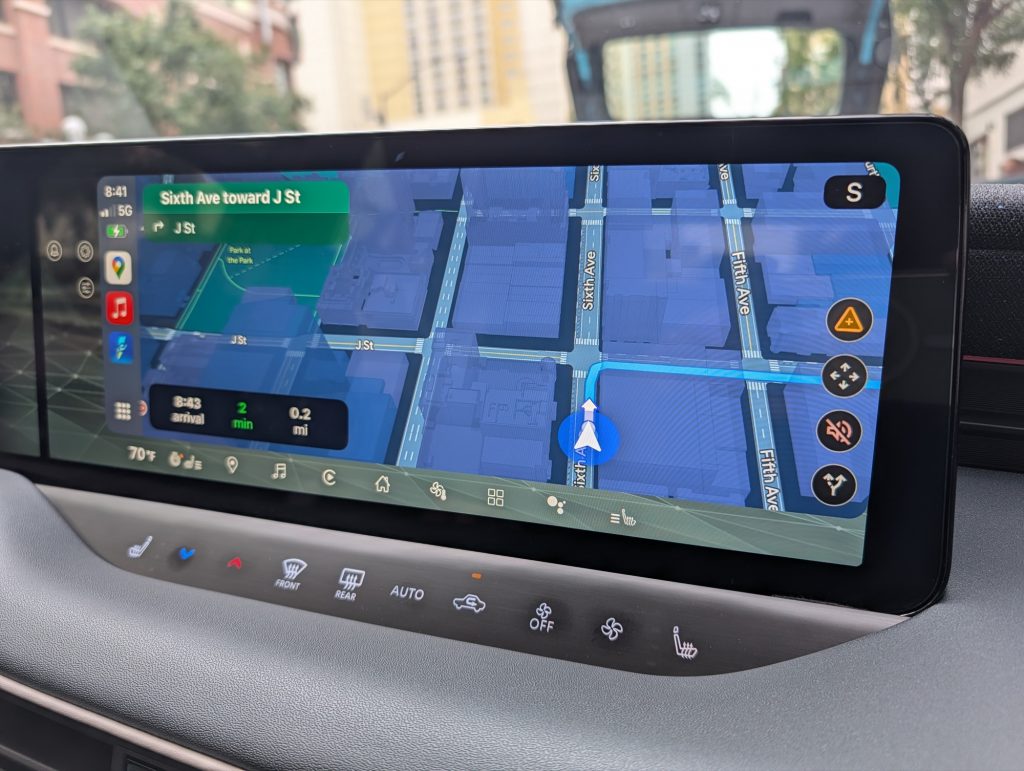
Stepping up to either the SV+ or Platinum+ trims provides larger 14.3-inch displays and Google built-in software that includes Maps, Assistant and the Play store. Google Maps is integrated with the vehicle and the state of charge to provide route planning that includes suggestions of where to stop for charging and estimated state of charge on arrival. Drivers can also download additional apps for media streaming and other functions. However, this system requires connectivity to function and unlike GM which includes eight years of data for the Google services, Nissan only provides 1 year. After that you’ll have to pay up for a data plan for your car or go back to smartphone projection.
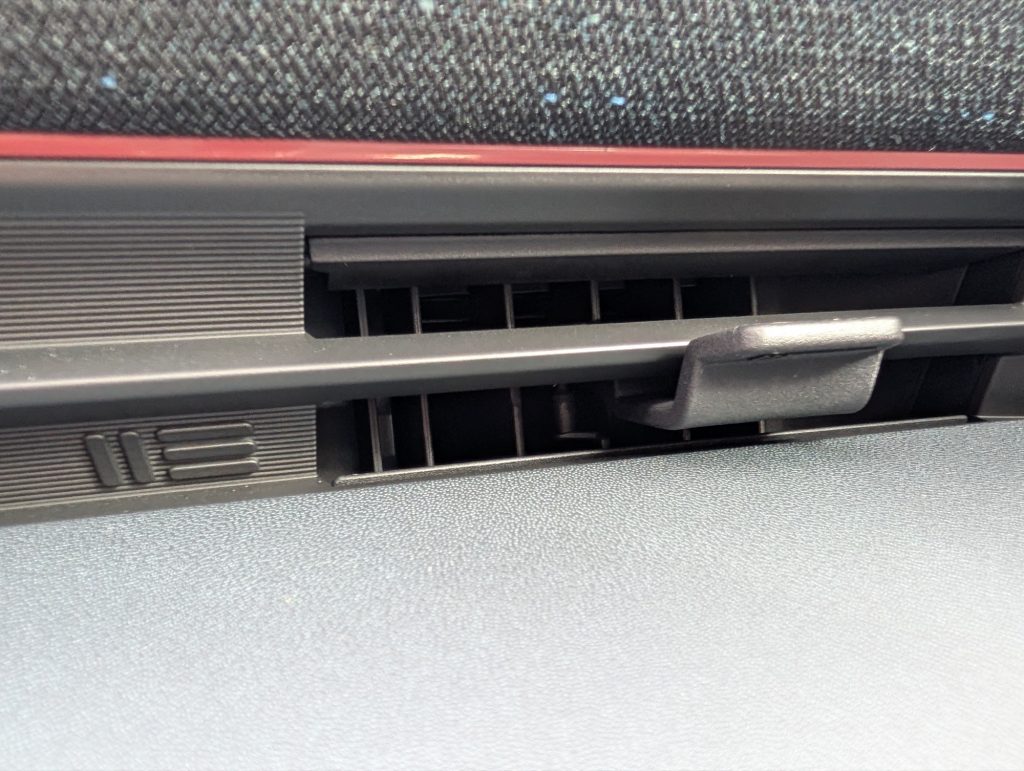
One thing we were happy not to see in the Leaf is an overabundance of piano black plastic. Over the years, we’ve criticized Nissan for apparently having purchased a long-term, high-volume supply contract for piano black plastic (see the interior of the new Armada) and this material inevitably ends up looking bad pretty quickly as the surface collects fingerprints and dust. The only signs of this in the Leaf are a quartet of small buttons for the camera view, hazard lamps and next/previous surrounding the central volume knob. The rest of the interior is matte finishes with nice textures that should hold up well. I particularly liked the fabric covering across the top of the door panels and dashboard that is present on all trim levels.
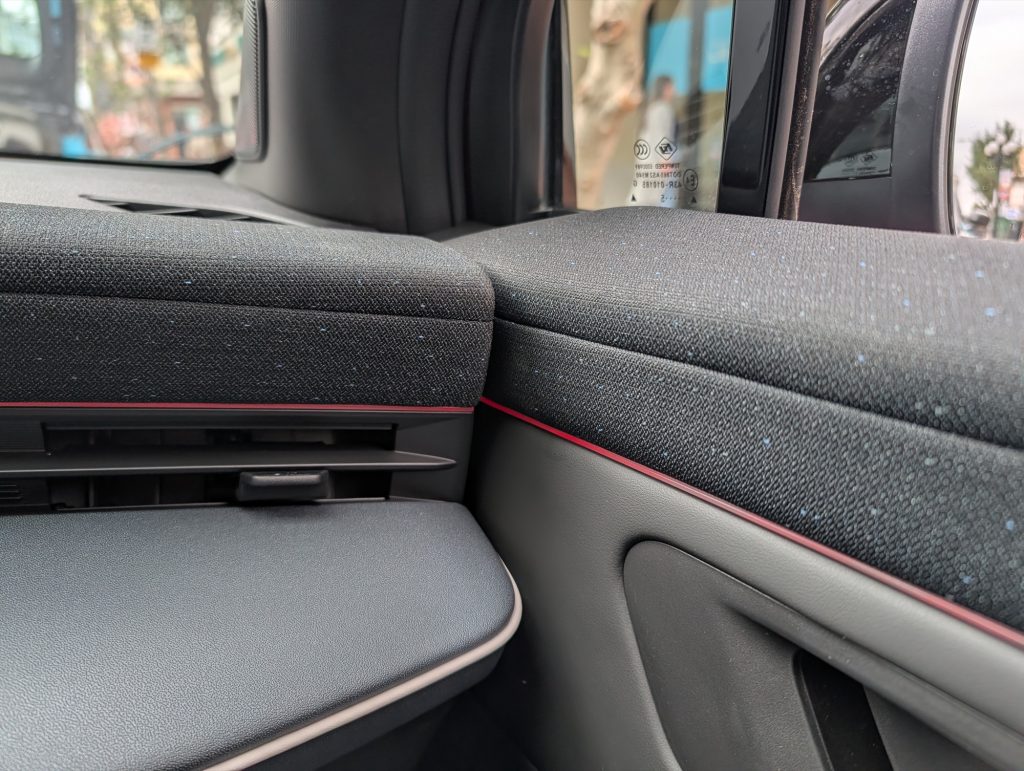
The entry trims get fabric covered seats while the two upper trims get a very nice synthetic leather and as usual, Nissan’s “zero-gravity” front seats were supportive and comfortable. Even after four hours in the car, I had no aches or cramps.
While I personally like the relatively modest footprint of the Leaf which should make it easy to maneuver around cities, it does take a toll on rear seat room. With the driver seat set for my 5-foot-10-inch frame, I can sit behind myself and have about an inch of knee room to spare. However, there is almost no toe room under the front seats which means the Leaf will be fine for transporting younger members of the family, but if you have teenage basketball phenoms, they might not be so happy in the back.
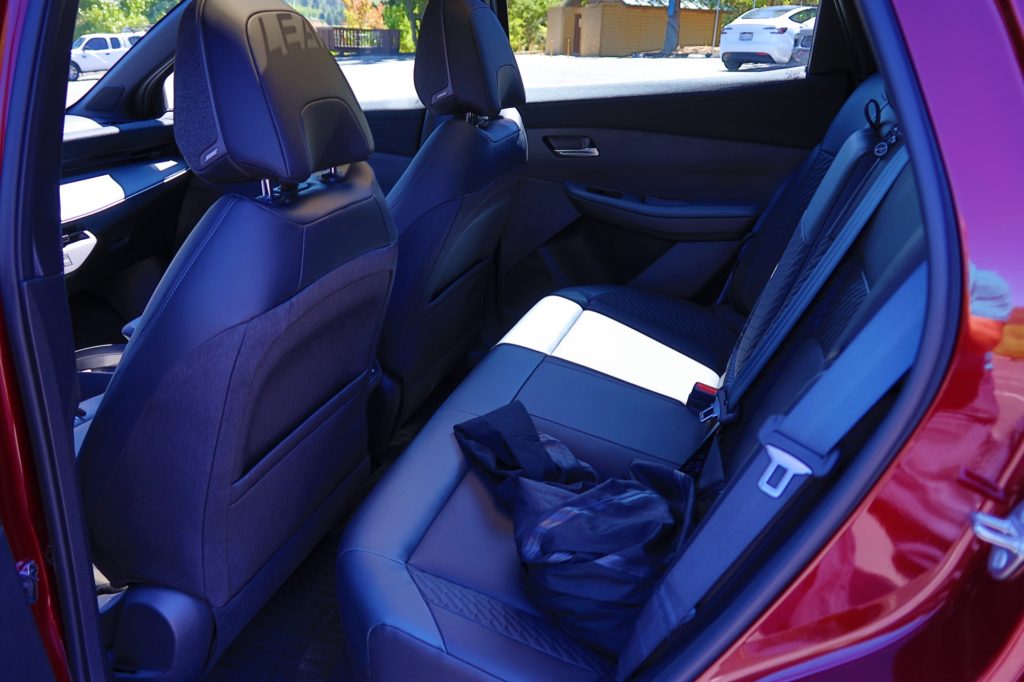
The Platinum+ also includes a glass roof panel with an electrochromic coating to transition from clear to translucent for some sun protection. Interestingly as you press the switch above the mirror, the roof goes opaque in sections as if you were sliding a traditional shade so front occupants can get full sun while those in the rear can get some shade if desired. The top trim also includes a heads-up-display.

Behind the rear seat you’ll find 20 cubic feet of cargo space that grows to 55.5 with the seats folded. However, since this is a front-wheel drive vehicle with a front overhang that is eight inches shorter than the previous editions, there is no frunk. All of the area under the hood is consumed by the powertrain and HVAC systems.
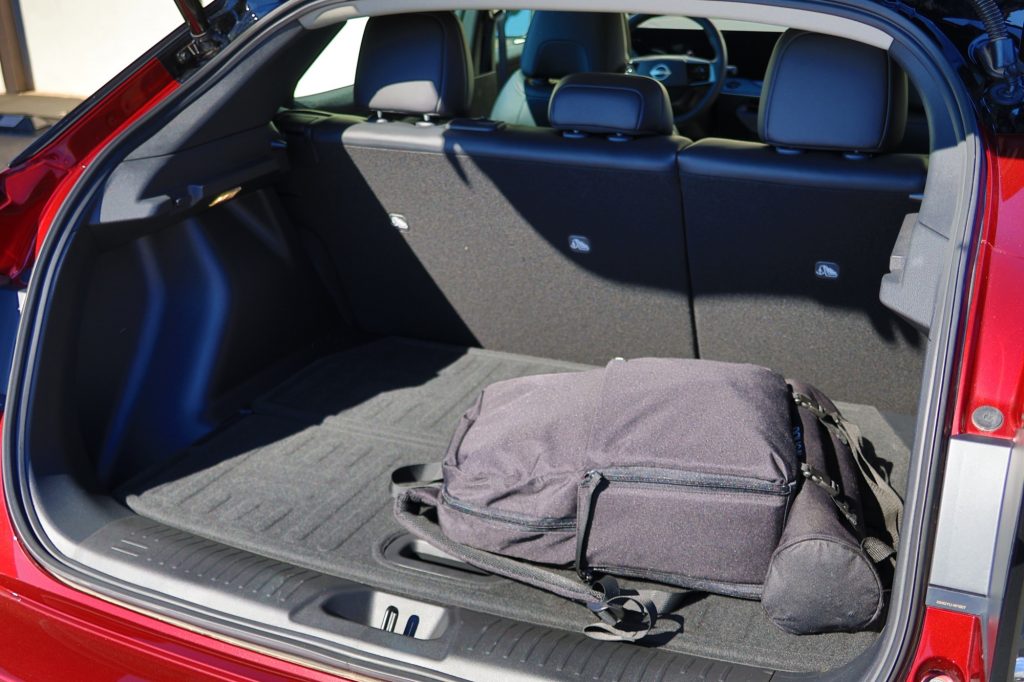
Speaking of climate control, it’s no surprise that some sacrifices had to be made to get the Leaf down to a $30K price point. In a world where dual zone climate control is pretty common even on a $22,000 Sentra, the Leaf only has a single temperature control for everyone in the car. Likewise ventilated seats aren’t offered even as an option on the Platinum+. Neither likely to be a deal killer, but they are details that had to be cut.
The Stuff You Don’t See

The new Leaf is built on the same Common Module Family (CMF) architecture as the Ariya and thus shares a lot of hardware with its larger sibling. The front suspension consists of MacPherson struts while the rear is supported on a four-link independent layout. Unlike the Ariya, there is no option for a rear motor to add all-wheel-drive to the Leaf. Nissan has also switched to a rack-mounted electric power steering actuator in place of the column-mounted used previously. This provides much more direct response and improved steering feel.
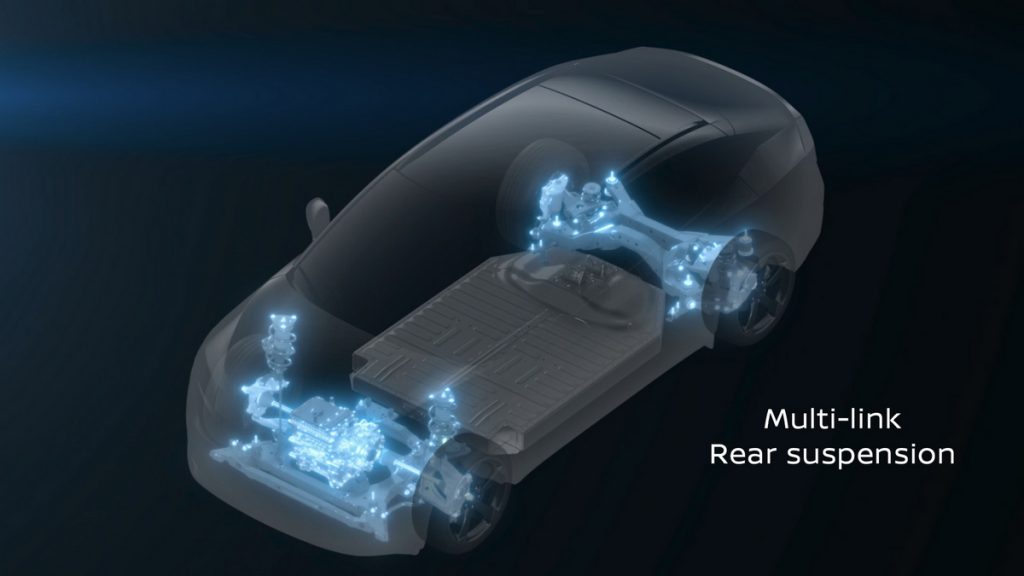
The Leaf is being offered with two wheel and tire sizes to start with. The base S and S+ get 18-inch steel wheels with full covers and 215/55R18 Yokohama all-season tires. The SV+ replaces the steel wheels with alloys of the same size. The Platinum+ steps up to 19-inch alloys with 235/45R19 Bridgestone Alenz tires. According to Christian Spencer, senior manager of vehicle evaluation and test, they provide the same performance specifications to all tire suppliers. Both combinations should provide comparable performance and all have the same suspension tuning so there is no functional advantage to going with the 19s, it’s simply a matter of appearance, but I’ll come back to that later.
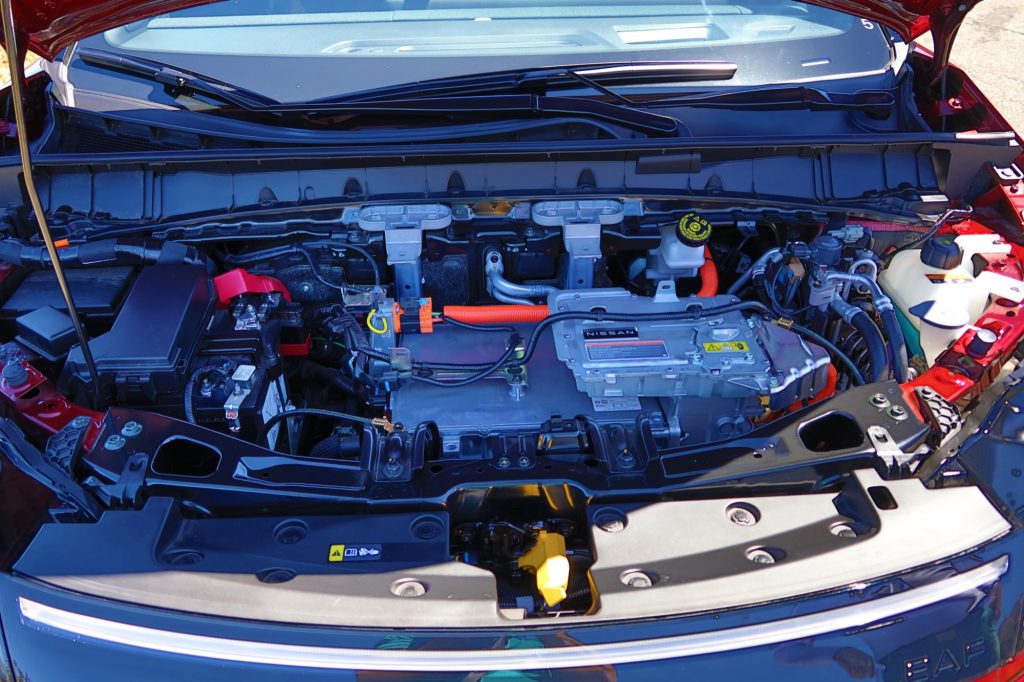
Speaking of the motor, the Leaf has a new 3-in-1 integrated drive unit that combines an oil-cooled, permanent magnet motor, the reduction gear set and the power electronics module in one housing. That makes it more compact than the old Leaf system, lighter, lower cost and cheaper to manufacture.
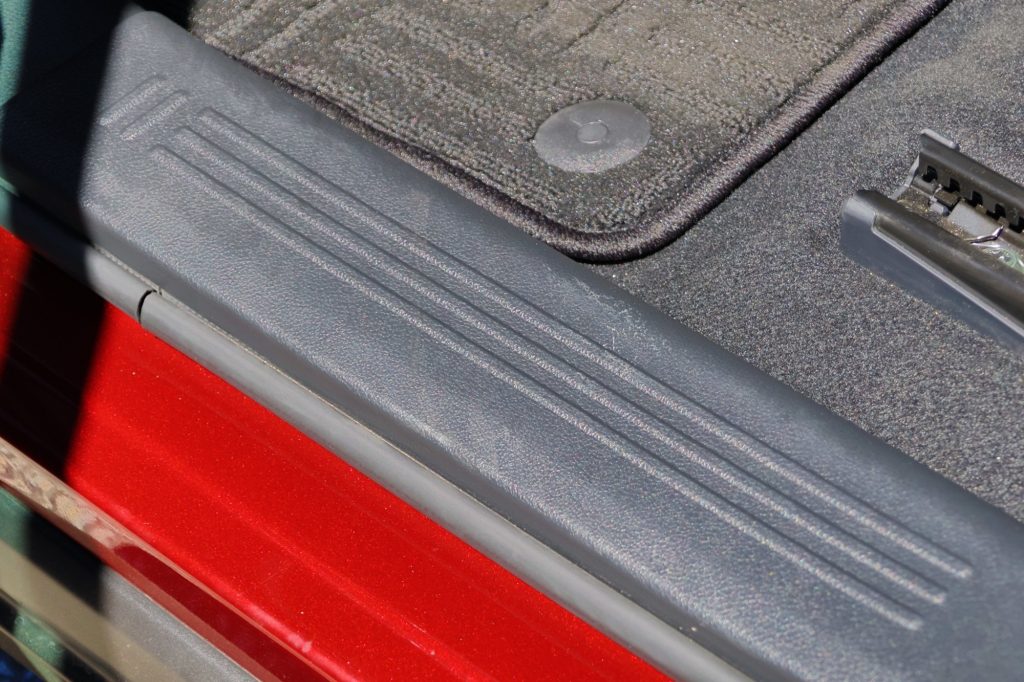
At launch, the Leaf is only available with a 75-kWh battery pack. A smaller 52-kWh version is coming in spring 2026 for the base S trim. With the larger pack, the drive unit produces the same 214-hp as the previous Leaf Plus but torque has increased from 250 lb-ft to 261 lb-ft. With the smaller pack, the drive unit will be limited to 174-hp and 254 lb-ft.
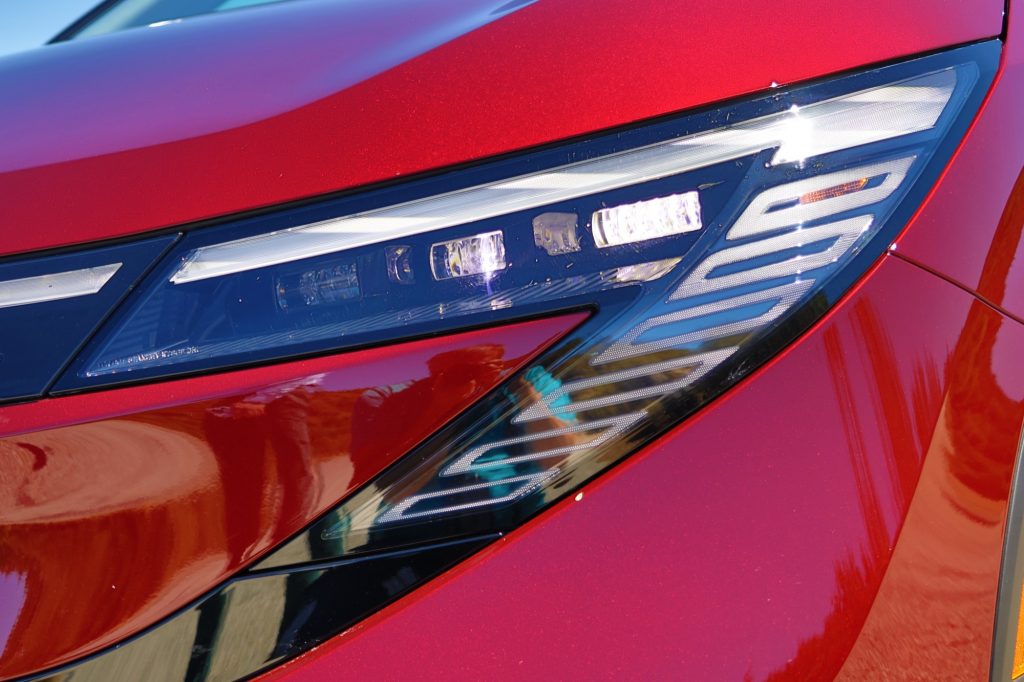
In addition to the new shape, probably the most important upgrade to the new Leaf is that battery. Back when the original Leaf was being developed in the late 2000s, cost was a critical element in trying to create a mainstream EV. Thus Nissan made the decision to go with an air-cooled battery pack while others adopted liquid cooling. Batteries, like humans, are quite sensitive to temperature and performance drops off significantly if it’s too hot or too cold. Unfortunately, when batteries get too hot, they can suffer permanent damage that degrades their energy storage capacity.
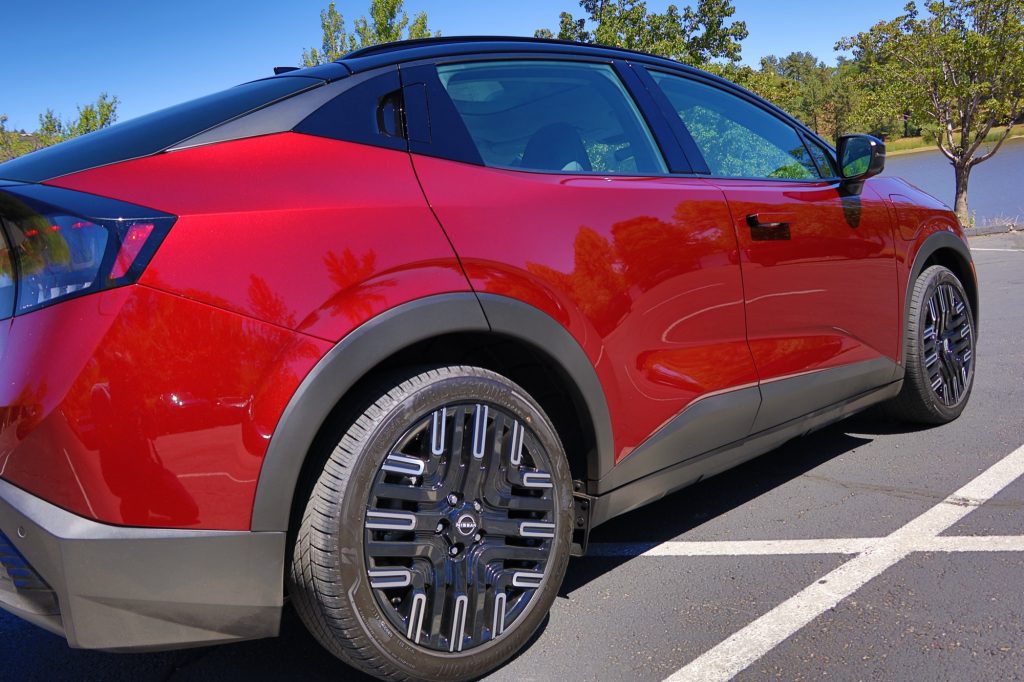
When the Leaf launched, it was initially only sold in the southwest including California and Arizona. In the early years, a lot of owners that were driving Leafs in hot weather experienced permanent loss of capacity fairly quickly. As mentioned above, beware if buying one of these.
This time around, the Leaf has a liquid cooled battery and also an available integrated thermal management system. The battery pack is using the latest nickel-manganese-cobalt (NMC) cells from Envision AESC. AESC began as a joint venture between Nissan and NEC and has supplied the cells for all the Leafs to date. On the S and S+, the liquid cooling will keep the battery from over-heating.
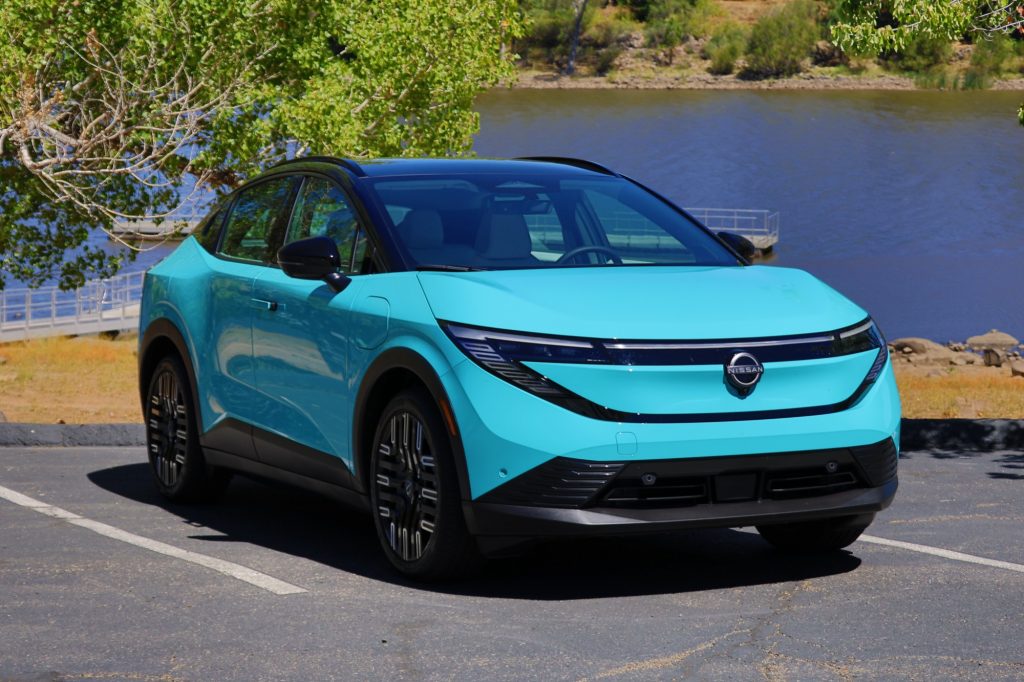
The integrated thermal management ties the HVAC, battery, motor, on-board charger and radiator together to maximize efficiency and get heat where it’s needed. If it’s cold and the driver has the heat on, the system will pull excess heat from the battery, motor and power electronics for the cabin. Standard on the Platinum+ and optional on the SV+ is the ability to heat the battery if it’s too cold to get it into the temperature range needed for maximum charging. This will help avoid the problem of extremely slow or no charging in sub-zero temperatures. According to Nissan, the Leaf will provide similar charging rates from those sub-zero conditions to the 90s and beyond.
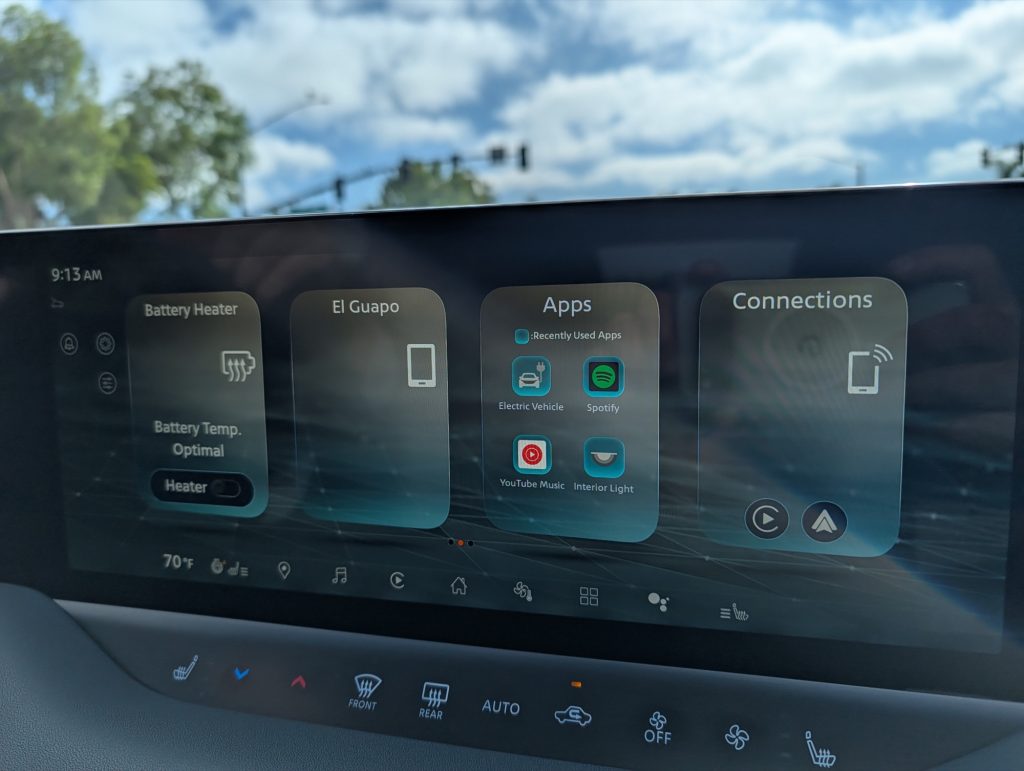
When connected to a DC charger, the Leaf supports peak rates of 150-kW, a big step up from the 50-kW CHAdeMO system and a 10% to 80% charge should take about 35 minutes, roughly half the time of the prior generation despite a larger battery. When equipped with the battery heater, preconditioning of the temperature will occur automatically when a charging station is set as the destination in the navigation. When not using the built-in navigation, the battery heater can be engaged manually in the settings. AC charging is also improved with a standard 7.2-kW on-board charger in place of the 6.6-kW unit used previously. We didn’t get an opportunity to test out any of the charging so that will have to wait for a future test.
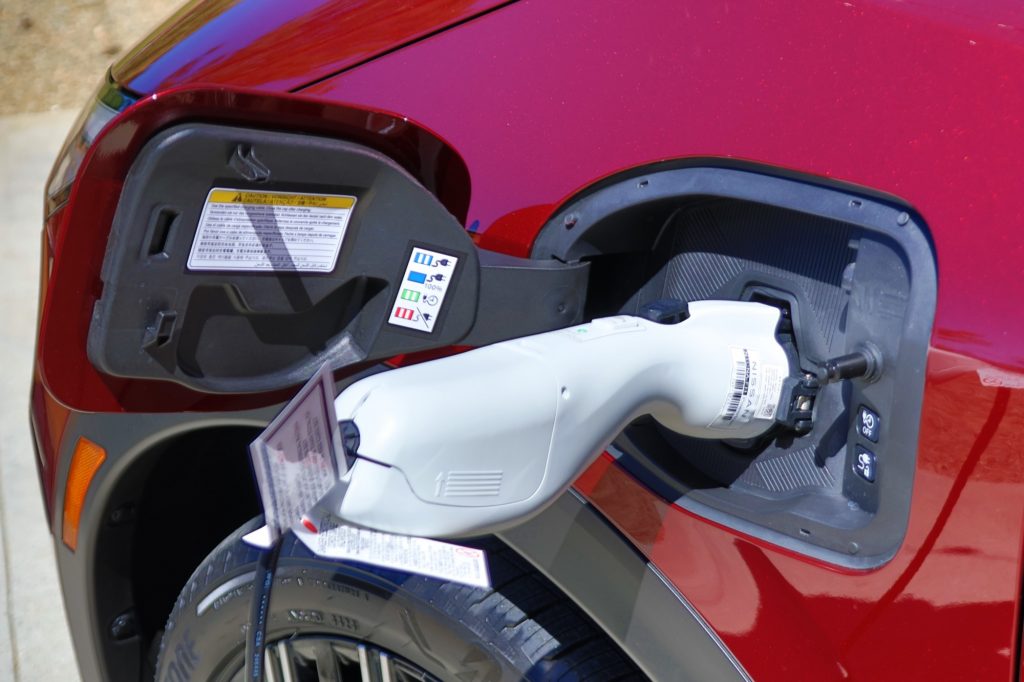
The new Leaf now has the capability to export power through vehicle-to-load. This can be done two different ways. There are two 120V AC outlets in the car, one in the cargo area and another up front by the console. They can put out up to 1.5-kW which can actually power a surprising amount of stuff at a campsite or even if your power goes out at home. Just run an extension cord to the car and you can keep a refrigerator or two running along with some lights and other devices for a couple of days. Another 1.5-kW can be exported through the J1772 charging port using an adapter similar to one offered by Hyundai. Nissan has designed one that will be manufactured by a supplier in the coming months.
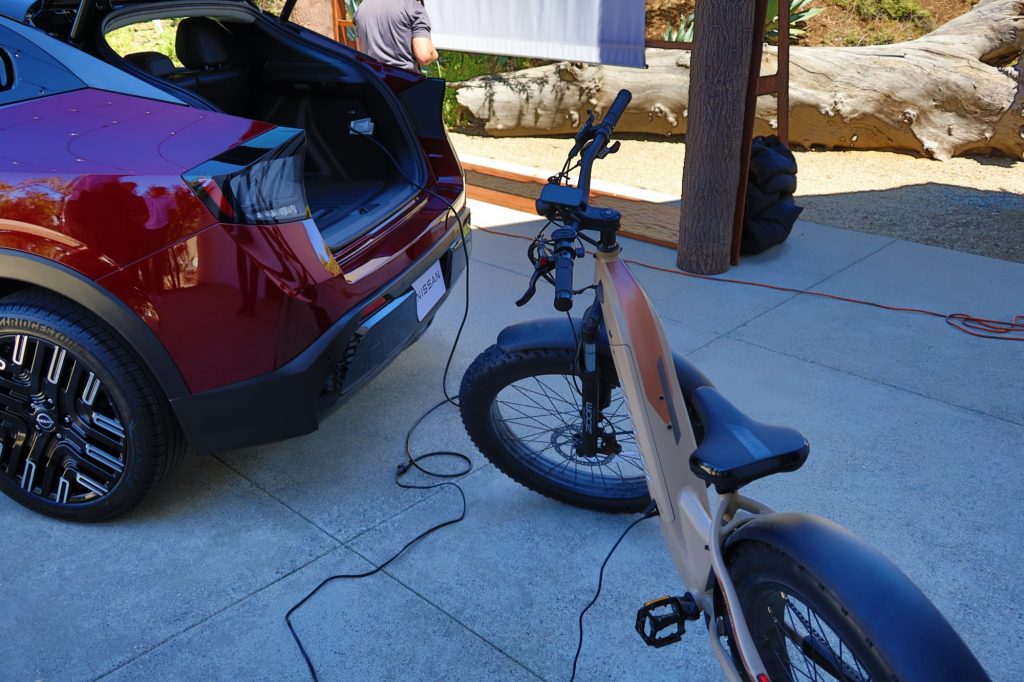
Into The Mountains
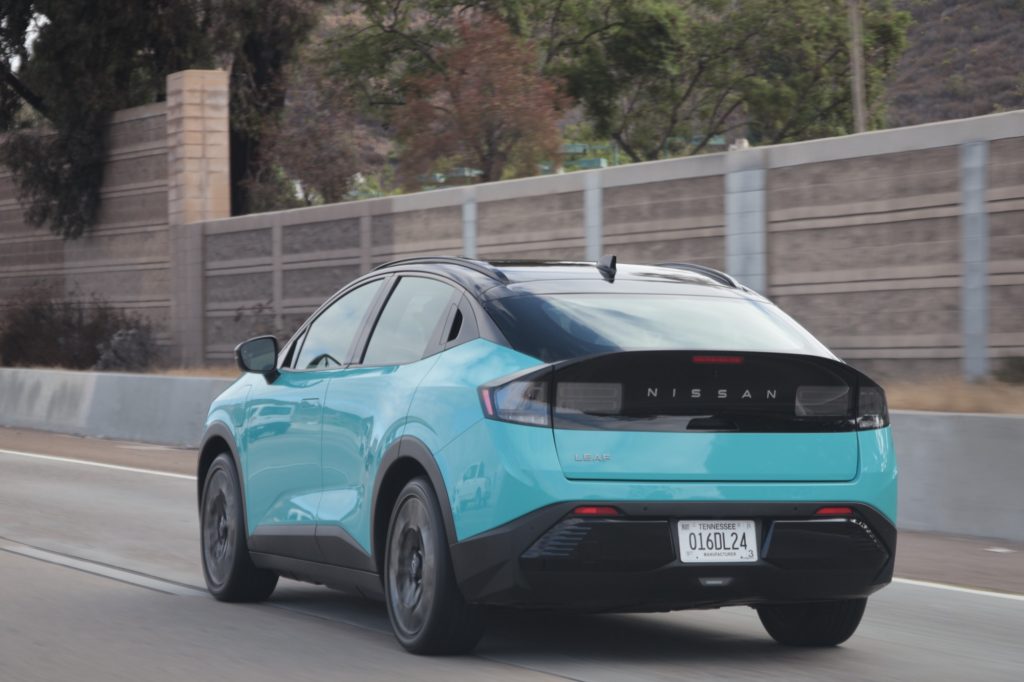
For our first drive, Nissan only brought out a fleet of Platinum+ cars in a choice of Coulis Red Pearl or Seabreeze Blue Pearl, both with a two-tone black roof. That means we had all the options including the 19-inch wheels and tires.
We set out from downtown San Diego and headed north on the freeway before turning east into the mountains for a few hours. At highway speeds, it was immediately clear that the more aerodynamic shape of the Leaf was paying dividends in quietness although our pre-production car did have the slightest hint of wind noise around the passenger door, likely due to a flawed seal. It wasn’t much, but given how quiet everything else was including road noise, it stood out.
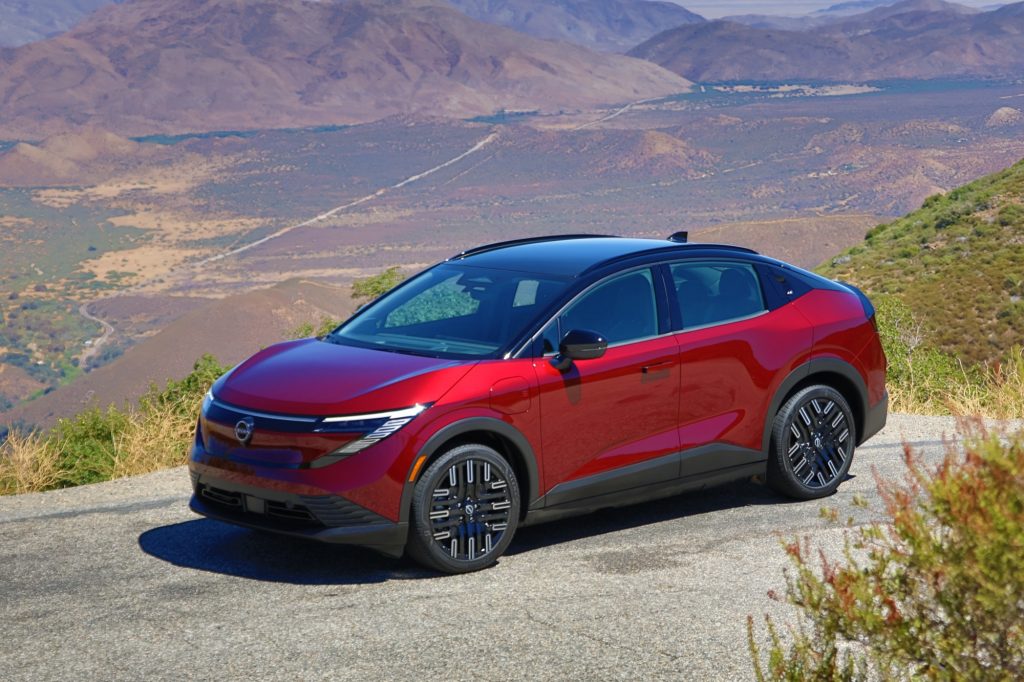
Beyond that, it was very comfortable to ride in. The Leaf does include the ProPilot Assist V1.x which is a hands-free system that was also on the previous generation as well as much of the rest of the current lineup. It combines adaptive cruise control with hands-on lane centering and also includes curve speed adjustment. One thing we did encounter on a couple of occasions was a warning that the system was unavailable and the sensor needed cleaning. Each time it happened when the sun was above and potentially shining into the front camera because it resumed by itself shortly after. I’ve encountered this same issue in the past on the Ariya which uses the V2 system with hands-free capability.
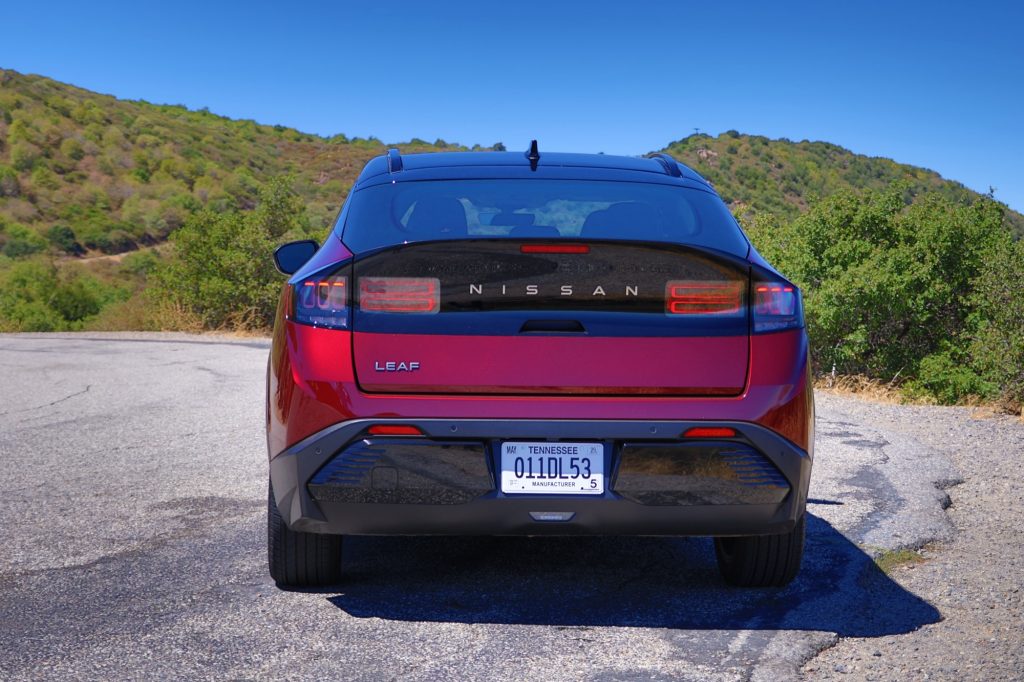
As we got into the mountain roads several things became clear. The new rack-mounted power steering makes a huge difference in feel. The steering is much more direct and precise with no play in the wheel. This might take a bit of getting used to because it can feel almost twitchy at first, but once you’re accustomed to it, it feels much better especially on curving rural roads.
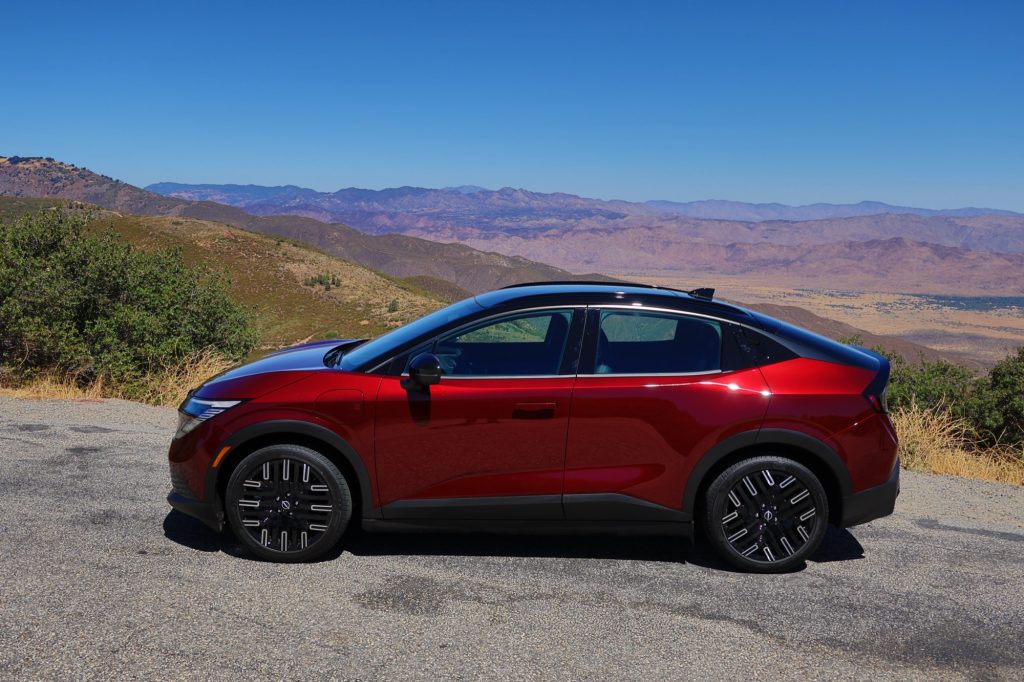
The other characteristic is that the suspension is well controlled and body roll is minimal, especially compared to prior Leafs. However, as the pavement gets a bit more broken, you also tend to feel it a bit more. I wouldn’t go so far as to describe it as harsh overall, because the wheel control is quite good, but there is a bit of impact harshness on cracks and heaves. This can largely be attributed to those 45-series 19-inch tires which don’t offer much sidewall. Hopefully I’ll get a chance to try out the SV+ at some point, especially back in Detroit. The slightly taller sidewall should provide more compliance over those small, sharp impacts and should hold up better against Michigan potholes.
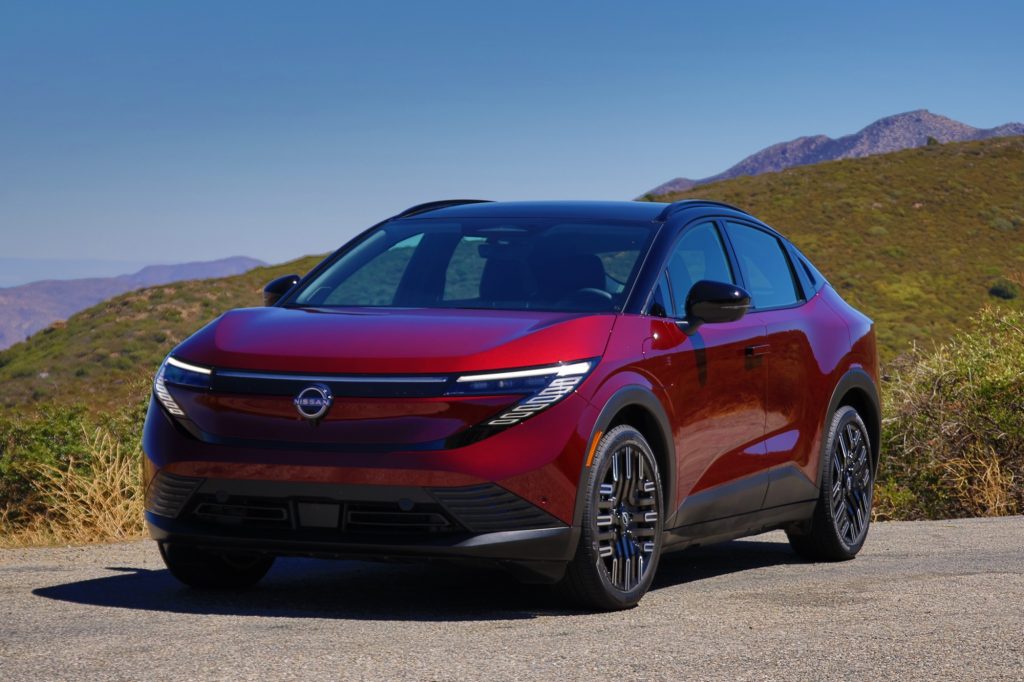
The Leaf isn’t going to be challenging a Model Y Performance for any pink slips at the drag strip, but the instant responsiveness of electric drive always feels good in daily driving. The 214-hp is more than sufficient for merging onto busy freeways and making passing maneuvers on two lane roads. Foot to the floor it will even chirp the front tires on occasion. At the limit in cornering, the Leaf, like most mainstream front wheel drive cars, will understeer, but up to nine-tenths of its capabilities, this is actually a surprisingly fun car to drive on a mountain road.
One-Pedal or Not?

One area that many veteran EV drivers will find disappointing on the new Leaf is the absence of a one-pedal driving mode. Prior Leafs had an e-Pedal button on the console that would enable maximum regenerative braking and the ability to bring the car to a full stop simply by modulating the accelerator pedal. Many EV drivers love this feature once they get used to it and it’s particularly useful in stop and go conditions so you don’t have to keep going back and forth between two pedals. However, every vehicle that offers this also has a more relaxed mode that more closely emulates engine braking in combustion vehicles.
Like the Ariya, the Leaf now has an e-Step button on the dash. Regenerative braking can be managed two ways in the Leaf. Steering wheel paddles can be used to adjust the degree of regen and at its maximum setting, will slow the car down until you get to about 10 mph at which point regen phases out and you have to hit the brake to stop.

Pressing the e-Step button gives just a bit more regen, but it also moves the brake pedal in proportion to how much deceleration there is. When you do go to apply the brake, which you must do to come to a full stop, you will often find the pedal halfway down already which is a bit disconcerting when you are used to it being at a certain height. I and most of the others on the drive really disliked this approach and pressed Nissan to bring back e-Pedal as it was. The hardware can do it, it’s just a matter of a software change. It sounds like the new approach is being pushed from the home office in Japan, but it is still being discussed. In the meantime, I’d suggest not using e-Step and just tapping the paddle to maximize what regen is available.
How Far, How Much?
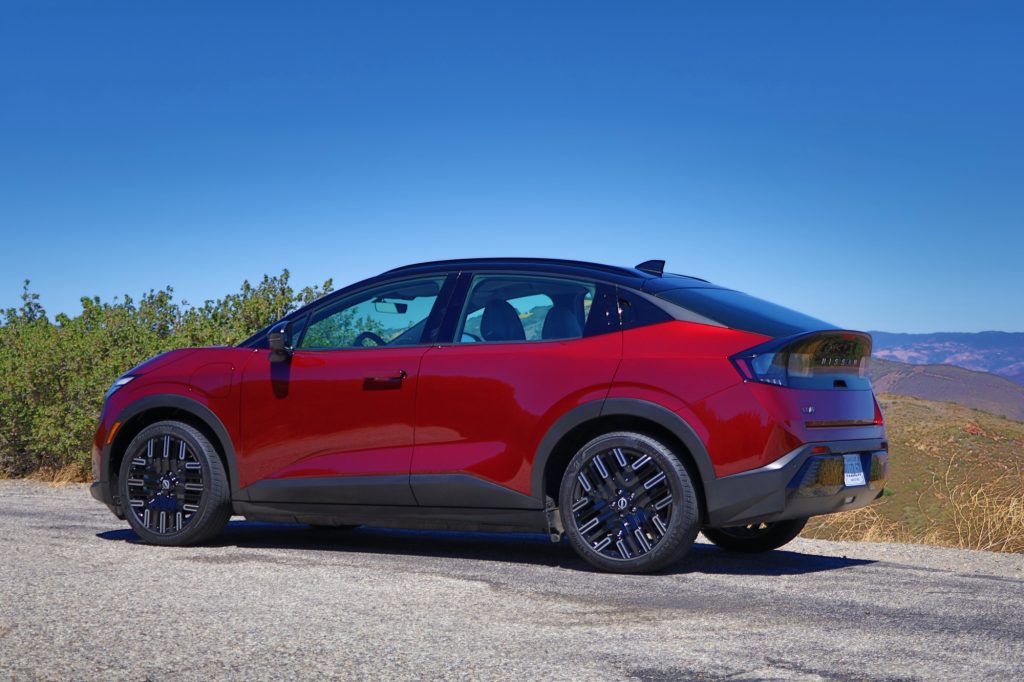
The 2026 Leaf will be in US Nissan dealers in the coming weeks. Through the development process, Nissan made decisions based on the assumption that tax credits wouldn’t generally be an option because the car is no longer being assembled in the US. The new Leaf is exclusively assembled in Japan. That led to some decisions like the absence of dual zone climate control. But overall, this new edition feels far less cheap than the prior model; not premium, but not cheap.
For launch, there will be three trim offerings, S+, SV+ and Platinum+ priced at $31,485, $35,725 and $40,485 including delivery charges. All three come with the 75-kWh battery and have ranges of 303 miles, 288 miles and 259 miles respectively. The reduced range is due to increased weight as features are added and the bigger wheels. The 52-kWh S trim should be about 8-9 months behind, so sometime in spring 2026. Nissan isn’t talking price or range for that version yet, but the only difference between the S and S+ is the battery size, other equipment is identical. I estimate that the 2026 Nissan Leaf S will probably sticker for between $27,000 and $28,000 and offer about 220-230 miles of range.

For now, the Leaf offers a very impressive value proposition especially for someone interested in getting their first EV or even their first new car. At just over $31K delivered, this isn’t far off the price of a comparable gas vehicle and it offers 300 miles of driving range on a charge. As usual, the middle trim is the sweet spot though at less than $36K for almost 290 miles of range and an impressive list of standard features. While the old Leaf was totally competent, but utterly dull, this new generation is actually surprisingly fun to drive and pleasant to look at especially in Seabreeze or red. If only Nissan would relent on one-pedal driving.

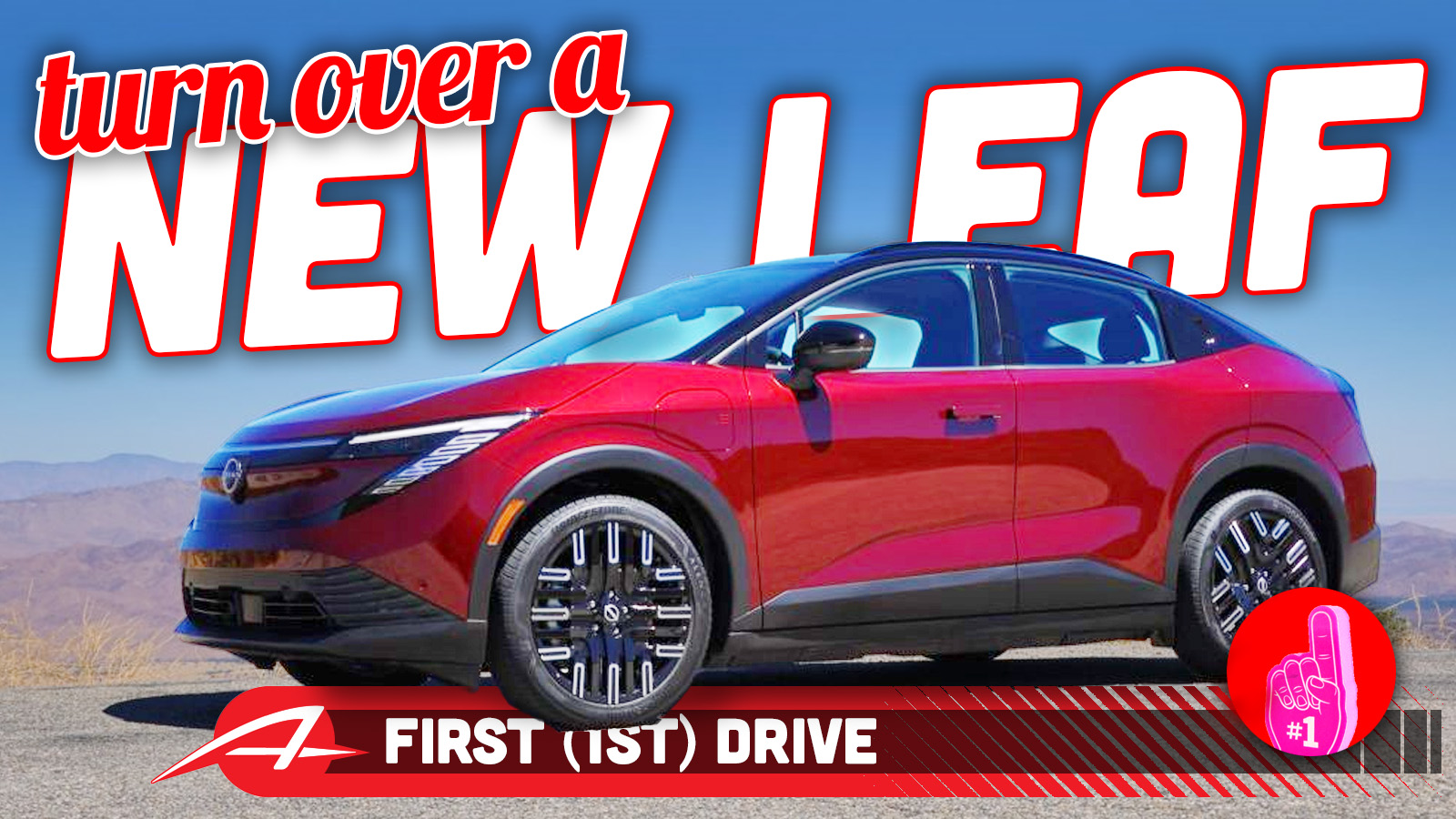






Hah! Sort of looks like a chubby Volt
I was thinking “Japanese Model Y”
Genuinely curious here. Is there something inherent in low-profile tires that gives them less rolling resistance or something? I found this car truly intriguing until I read that the base model comes with 55-series tires. These are basically city/suburban cars, where the roads are crap, and anything with 55-series tires is going to feel like a buckboard on those roads.
Maybe I’m getting old, but for a daily driver, I don’t want to see any aspect ratio below 65 on my tires. Performance cars, fine, but not on a daily.
I don’t know of any passenger cars over 65. Keep in mind that tires are wider these days, so actual sidewall height may be higher, but the series number skewed.
Yes, of course. Something like a 255/55 would have plenty of sidewall.
When I was shopping for my CUV, I deliberately chose the lower trim version because it has 225/65-17 instead of the higher trim that has 225/55-19. I like sidewall.
Stiffer sidewalls might help range some, but I think that’s more than balanced out by the larger spinning spokes. Especially at highway speeds, which is the only place range really matters past 150 miles or so.
It’s more that big wheels are “premium” and trendy. It’s basically just aesthetics, though in my opinion on a car like this they just look goofy and oversized.
I hope it’s a hit! Looks great!
What is good about electric door handles?
I guess they reduce drag by like 0.02%, maybe?
I really don’t hate it. Hell, I think I might even like it? This seems to be a relative sweet spot for pricing, assuming they actually build the S+ and that they’re readily available. 32k for 300 miles of range in a relatively useful package seems like a winner to me. In a world where a compact sedans are in the 25-35k range, 32k for an electric commuter seems genuinely fair to me.
As for the form factor, it’s a small hatch. There’s nothing about this that appears to even make it a crossover, other than marketing and cladding. If that’s what’s required for us to have options for vehicles that aren’t taller than I am, so bit it. Hell, looking it up, it appears the new leaf is a half inch shorter than the old one. That’s a win in my book.
I like it? Yes, I do a lot. I think Nissan is ahead of what the next Chevy Bolt will be based just on spy pictures. Its all about the price and incentives from Chevy or Nissan in this case. The big plus is having Apple Carplay available, something that the next Chevy Bolt I am 99% sure will not have.
I like it! Looks kind of cool but not too weird. 300 miles for ~$30K. And oooooh baby, a volume knob!
Uff da. I think those looks are going to hurt sales a bit.
I think it’s a big improvement over prior Leafs of course, and I hope it sells well for Nissan’s sake. I don’t mind the size or shape at all, though it’d have been more interesting to me personally were the roof flat all the way to the back of the car, making it a more useful little wagon. The Seabreeze blue is lovely IMO (I know some hate it for inexplicable reasons) and that’d definitely be the color for me. Though I like the design of the alloys, I’d avoid them because I’d rather have a bit more ride comfort from the smaller steelies. I could probably even get by with the smaller battery in the S. I don’t want/would never use all the ProPilot self-driving stuff, but it’s standard, and even if it were possible to avoid it, deleting it wouldn’t reduce the cost of the car much.
All in all, the new Leaf seems a very decent little car. I definitely approve of the improved steering feel, and hope a software upgrade returns true one-pedal driving (which I first experienced on a BMW i3 and really enjoyed for city driving). I wonder if base models with the smaller battery will eventually get down to the mythical $25K EV mark (assuming it doesn’t sell too well and dealers eventually discount it, which given American conusmer tastes, isn’t impossible).
Thanks very much Sam. I’ve already watched a bunch of new Leaf reviews on Youtube, but I was looking forward to Autopian’s take on it and yours is very appreciated. 🙂
But he did. And I’m sure Nissan fought him kicking-and-screaming the whole way.
The Renault Zoe, and Renault Kangoo E-Tech both came in the 2010s. With far wider range of BEV/HEV options out now.
This is actually pretty intriguing. Did you get a chance to test highway speed(ish) NVH? Gotta know that for my highway commute
It’s pretty goofy looking to my eye, but seems like an overall good package. We need more EVs in this segment, so I’m really happy to see a new Leaf hit the market.
All very good. I’m curious the maintenance schedule on these bits. Learned our Ioniq 5 has more items than expected:
That’s interesting and I didn’t know it. Thanks WWOKN. 🙂
Holy crap. You just made me look at the schedule for my vintage Fiat 500e. The battery cooling flush isn’t required until 10 years or 150,000 miles, which ever comes first. The center gear doesn’t have a required change schedule for oil change. My first one was wrecked at just north of 120K miles. I never bothered looking at the book until now.
Wow. That’s a lot of maintenance. How many coolant loops are there?
http://autoresearchblog.com/uploads/3/4/8/4/34849778/2023-hyundai-ioniq-5-under-the-hood_orig.jpg
2 on the ’22 – ’24 Ioniq 5’s. Blue is every 40k. Pink is much longer interval. No idea why they eliminated it on the refresh and Ioniq 6.
Nice. When the lower battery capacity trim comes out I may just pick one up as our 2nd car. Range is irrelevant for errand runs and for teenagers learning how to drive.
My 2021 Leaf S+ is the car my kids (18 and 20) learned to drive in. It was my daily for several years and I can confirm that it is hands down the easiest car to drive that I have ever driven. It just does what you tell it to do. There’s no awkward shifts or or power surges, no defined power band. The software limits torque from a stop so you basically can’t peel out even if you try. But at any speed, full torque (250 lb-ft) is available with no delay. Visibility is reasonably good except for the thick A pillars and the dimensions make parking easy. It’s actually quite a bit more fun to drive than the reviews ever gave it credit for. My 18yo son finds it to be a plenty sporty ride.
Honestly, a used gen 2 Leaf represents a really good value for a new driver car if you have home charging. There are some downsides to deal with (that don’t have anything to do with the battery range or life) but once you get over those, it’s an amazingly competent and simple car to own and operate.
Huge improvement in looks, the first generation looked like a bottom sucking fish, the second generation was okay looking.
El Guapo? Really? I mean, it’s your phone, I guess.
Sam must be a “Three Amigos” fan 😉
This is a compelling package. It has good range, adequate power, and the versatility of two different charge ports is a stroke of brilliance that I hope other manufacturers follow. This thing can be road tripped through the US with almost no issue at all…and it’s two of my favorite Cs-cheap and cheerful. I hope they sell well, because this is probably the perfect amount of car for quite a few buyers.
As I’ve been saying for weeks now…as the second generation products start to hit lots BEVs are becoming mighty appealing. The combination of 300ish or more miles of range and NACS ports basically does away with range anxiety completely, unless you’re someone that’s constantly looking for excuses not to consider an EV, of which there are many, to be fair.
Good lord am I the only person on earth who thinks if you’re gonna go the capacitive touch route for ANY button in a vehicle you should probably pick a material that isnt going to absorb and hold the natural grease from humans fingers??
THIS is going to look terrible after just a few thousand miles of driving and for the rest of the vehicles life.
Interiors should be designed and materials should be chosen carefully to insure that they look clean after 20k+ miles even if they necessarily are not.
ALSO the PRNDL buttons gotta be the cheapest ive ever seen lmao
The dual charging ports are interesting. As you said, in this case it’s to allow both standards, however it would actually be pretty useful to have duplicate ports: using charging stations would be a lot easier and, for houses with two EVs in the garage, you wouldn’t be limited in terms of which car has to park in what direction on what side (ask me how I know…)
The ideal would be to have a port on every corner, but at least one per side would be an improvement and shouldn’t be that hard to engineer.
Wonder if you can plug into both DCs at once. DUAL POWER
lol. So many times when I’ve been using a public charging station and thought “you know what could make this experience even better? if there was a way one car could use two stations at the same time.”
Huh. I like it. I don’t have the money to buy one now and don’t really want to drop my 6sp Mazda3, but I assume eventually I’ll be buying an EV and if this one sells ok and proves to be reliable I’ll keep it in mind for my commuter down the line.
The PRND buttons might be the shittiest looking buttons I’ve seen on a modern car.
My thoughts exactly. Also the HVAC buttons absorbing the grease from your fingers would make me freak out. What a terrible couple of decisions made regarding arguably the two highest frequency touch points on a vehicles interior
I agree that the shifter and HVAC button materials were poorly chosen. Can’t have everything I guess. Maybe they’ll be tweaked to better-wearing surfaces when the half-cycle refresh happens, but those poor choices wouldn’t keep me from buying a Leaf.
Yes, the plastic of the buttons doesn’t match the surround, and both look cheap. Font selection was phoned in too.
It almost seems like the whole dashboard design is going for some kind of retro-80’s look.
Probably a good thing, really. Remember when all those fancy ‘soft-touch’ plastics in 2000s cars turned into crayon mush a decade in?
I’ll be the pedantic one to chime in, but it’s just the wheels, weight, especially in the single digit percentage range, has next to zero impact on EV range, but the aerodynamic effect of larger wheels is truly massive. The play here is get an SV+ and some S+ wheels, and you’ll get right back to that 300 mile range.
I’d be curious to see the weight of the wheels. Ioniq 5 nets huge mileage gains by switching even the smaller 19″ oem’s for aftermarket light weights, even non-aero types.
We now live in a time when 19″ers are ‘smaller’ and more than a few cars come with 23-24″ from the factory. Has no one ever paid for tires?
Except here the Leaf S with the steel wheels, has 15 mile more range than the SV which has the same size wheels but in alloy.
But the S and the SV+ have the same 18″ wheels and tires. Why would the SV+ lose 15 mile in range? The SV+ does have alloy wheels, which are sometimes ~1/2″ wider than steel wheels, but it’s hard to believe that would cause a 15 mile hit to the range.
Hmm. Commenting before finishing reading to add a thought about the hatchback vs SUV nomenclature. It’s kind of unbelievable that this is smaller than the last version, but makes sense.
As for how this is an SUV, I think that’s become less about seating position and ride height and has something to do with the greenhouse/body side ratio and related belt line. I’m not sure exactly what this is, but as the owner of a Mazda3 hatch and a lover of all things hatchback, this reads as an SUV (or rather CUV) to me.
We need Torch to create a naming standard, similar to wagon/hatchback/shooting brake.
It’s the batteries under the floor. What we have here is a fairly standard lift back sedan profile, but it’s been given a ~3 inch ‘body lift’ to make space for the batteries. The doors and fenders have been stretched vertically. Image the greenhouse and hood sitting lower, and you can spot the ‘car within’.
This is just going to be the reality until battery density improves. Marketing wise, it’s easier to mask the vertical stretch with black cladding and call it a crossover, than let it be judged unfavourably next to svelte ICE sedans. Kinda the same thing with the GM EVs- the Blazer & Equinox are just station wagons.
I remember the first time I rode in a Tesla Model 3- it felt like stepping into a Civic, but someone had left a phone book under the floor mat.
I certainly agree that packaging EV’s will lead to more CUV body styles, but it’s not impossible to make a true car/hatch with batteries. The Model 3 is the best example of that – there’s no doubt that it reads as a car and not an SUV even if the seating position is higher. There’s also the Ioniq6, Taycan, E-tron GT, i4/i5/i7, Lucid Air, Model S, etc.
Even the last gen Leaf is an example of a true “car” EV. I just don’t think that we should accept that all EV’s are still just “cars” just because they’re lifted due to the battery.
After all, the taller profile and styling of SUV’s comes from the early body-on-frame SUV’s which were taller due to the frame and running gear underneath, but there was still a definite distinction between SUV’s and body-on-frame cars of the time.
I don’t disagree, but all of the examples you just gave, including the Model 3, are larger cars, with longer, wider wheelbases. Much easier to disperse the batteries. There are still trade offs though- I have a 35” inseam and find the rear seating position in the Model 3 to be quite uncomfortable, where as I can happily ride in the back of a modern Civic or Corolla for hours. There is a reason the Model Y is considered to be the more desirable car.
Nissan actually pulled off a rather rare move with this Gen 3 Leaf. They added 15kWh of battery pack, plus more sophisticated systems…. While making the footprint SMALLER than the old car. Something had to give.. Based on the article, it sounds like the new car is already cramped in the foot well area. Trying to match the profile of the old car would have led to untenable ergonomics. So it’s a ‘CUV’ now.
We kind of have no choice but to accept that small EVs will look a bit tall for the next 5-10 years if we want acceptable range, low center of gravity and decent ergonomics in the same package.
Yeah that’s a good point. Still, though, in that case I think we just need to call them compact CUV’s (which is what the masses want anyway) just to preserve the hatchback, sedan, and wagon names as what they actually are.
Even without electrification we’re having to fight the “coupe” wars just to maintain the meaning of that word. Crossovers don’t get to be everything, dammit!
I’m probably in the minority but I liked the old body style better. I get that market forces are dictating it having the crossover coupe profile. It’s not for me though.
The AMC Eagle is getting its genius recognized a second time!
Same. The Gen 2 Leaf was a good design.
Not bad, but if you want one you’d better move fast, because it’s nearly Fall and these will be going fast. On the other hand, the best colors are usually available in autumn.
DO I havetohavethe black roof?